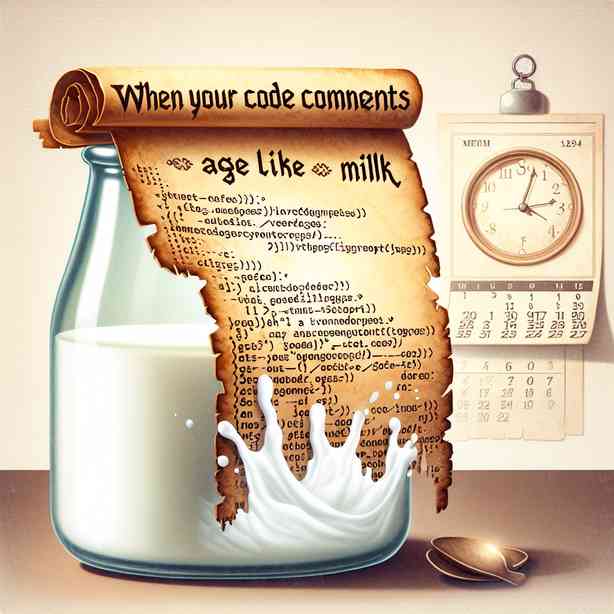
When Your Code Comments Age Like Milk
In the realm of software development, code comments play a crucial role in ensuring the understanding and maintainability of code. Code comments are akin to a roadmap, guiding developers through the intricate landscapes of complex algorithms and functionalities. However, just as milk has a shelf life, code comments can also “age” poorly. In this article, we will explore the reasons behind the deterioration of comments, the impact this has on software projects, and the best practices to ensure comments remain relevant and useful throughout the lifecycle of an application.
One of the primary reasons comments age like milk is due to changes in the codebase. As software evolves, original logic may be modified or completely rewritten, rendering previous comments obsolete or misleading. For example, a function that once performed a specific task may be updated to include new features or to optimize existing algorithms. If the comments are not revised alongside the code, they can lead to confusion and misinterpretation. Developers may find themselves wondering why the comments suggest a certain behavior when the code does something completely different. This disconnect can result in bugs being introduced into the system or previously understood functionalities becoming a source of frustration.
Another factor contributing to comment decay is the time factor. Software projects often span months or even years, and during that period, the knowledge within a team can change dramatically. New team members may join, experienced developers may leave, and the business requirements may evolve. As a result, comments written at one point in time may no longer reflect the current understanding or context of the project. It is essential to recognize that comments need to be treated as living documents that require regular updates and maintenance. Ignoring this responsibility results in a written record that eventually loses its accuracy and relevance.
Additionally, the nature of language itself can render comments ineffective over time. Programming languages evolve, and with them, the idioms and best practices associated with them. A particular way of expressing a concept in comments may be clear and widely understood at one moment but can become obsolete as practices shift. For instance, a comment that used to clarify a complex pattern may not resonate with new team members who are accustomed to different frameworks or technologies. For comments to serve their purpose effectively, they must align with contemporary standards and practices.
Moreover, comment fatigue can also occur within a team. This phenomenon happens when developers become overwhelmed by the volume of comments in the codebase. If every single line or block of code is commented, it can lead to a decrease in clarity, making it challenging to discern which comments are vital and which are redundant. Excessive commenting can create a sense of clutter, diminishing the value of the comments that genuinely contribute to understanding. Striking a balance between commenting enough to convey necessary information and not overwhelming the code with excessive notes is vital.
To avoid comments aging like milk, developers must adopt several best practices. First and foremost, comments should be written with clarity and intent. They should aim to explain the “why” behind code decisions rather than merely reiterating what the code does. For instance, rather than stating that a function increments a counter, it is much more informative to explain why that counter is being incremented. By doing so, future developers will have a better context and rationale for the existence of that piece of code. This approach not only aids understanding but can also help mitigate the risk of unnecessary changes being made.
Regularly revisiting and revising comments is equally important. Integrating comment reviews into code reviews can be an effective strategy. When developers collaborate on code changes, they should also assess related comments to ensure they remain valid and in line with the updated code. A culture of regular commenting audits can be cultivated whereby developers set aside time to revisit the comments, especially for critical modules prone to changes or high usage over time. Maintaining an updated commentary contributes to a healthier, more comprehensible codebase.
Additionally, leveraging tools such as documentation generators can help maintain an accurate relationship between the code and its documentation. These tools can extract comments from the code and compile them into a readable format, making it easier to identify discrepancies. This practice can enhance documentation efforts, ensuring that comments are not isolated in the code but also accessible in the broader context of project documentation.
In conclusion, the aging of code comments like milk is a common challenge faced by many software projects. As code evolves, the comments attached to it must also adapt to ensure they remain relevant and useful. By striving for clarity in commenting, fostering a culture of regular comment reviews, and leveraging modern tooling to keep documentation accurate, developers can combat the decay of comments. This proactive approach leads to a more maintainable codebase, reduces confusion, and enhances the overall efficiency of development teams. Ultimately, the effort put into keeping code comments fresh and meaningful pays off in the long run, ensuring that they serve their intended purpose throughout the lifecycle of the application. Through these practices, developers can create a robust code environment where understanding flourishes, and innovation thrives.


